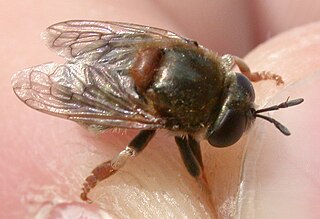Related Research Articles

The subfamily Microdontinae contains slightly more than 400 species of hoverflies and, while diverse, these species share several characteristics by which they differ from other syrphids. The Microdontinae are myrmecophiles, meaning they live in the nests of ants. Larval Microdontinae are scavengers or predators in ant nests, and, in contrast to other syrphid larvae, have no readily apparent body segmentation. Some species also do not exhibit the typical adult flower-visiting behaviour of other hoverflies, but instead remain near their larval host colonies.
Aristosyrphus is a genus of Neotropical hoverflies.
Ceratophya is a genus of hoverflies, with five known species. They are distinct from Microdon by the presence of an appendix on vein R4+5. Many species have erroneously been placed in this genus. Some authors place Ceratophya as a subgenus of Microdon.
Cervicorniphora alcicornis is a species of Australian hoverfly, and the only species in the genus Cervicorniphora.
Chrysidimyia is a genus of hoverflies from Brazil, with only one known species, Chrysidimyia chrysidimima. The genus was described as a small metallic green fly with dense punctation that had an "astonishing resemblance" to chrysidid wasps.
Furcantenna is a genus of hoverfly from southwestern China, Nepal and Peninsular Malaysia, containing three species. Furcantenna yangi is only known from males. Furcantenna is similar to the genus Schizoceratomyia. The two genera differ from each other in the shape of the scutellum; in Furcantenna a deep medial sulcus in its posterior margin divides the scutellum into two lobes.
Hovamicrodon is a subgenus of the hoverfly genus Archimicrodon, endemic to Madagascar. Hovamicrodon is distinguished by a particular type of scutellar calcar, being broad and blunt apically.
Indascia is a genus of hoverflies native to India and Sri Lanka. Indascia is very similar to Paramicrodon.
Kryptopyga is a genus of hoverfly native to Java, containing two species.
Masarygus is a genus of hoverflies native to Argentina, containing two species. It was first described as representing a new family related to Conopidae or possibly the Oestridae due to its much reduced mouthparts. Larvae are found in ant nests.
Megodon is a subgenus of the hoverfly genus Microdon. It is native to Madagascar, and contains only two known species. Microdon stuckenbergi has an unusual scutellum. Larvae are found in ant nests.
Mixogaster is a genus of hoverflies native to North America and South America, with 21 known species. Mixogaster is distinct by lacking an appendix on vein R4+5, having a reduced and bare metasternum, an unarmed scutellum, and usually an appendix on vein M extending in cell R4+5. Larvae are found in ant nests.
Myiacerapis is a subgenus of the hoverfly genus Microdon. It contains only one species, Microdon villosus. It is native to Uganda, though an undescribed species is known from South Africa. Larvae are found in ant nests.
Omegasyrphus is a genus of hoverflies, with five known species. These are small Microdontinae flies with a distinctive abdominal shape; the second segment is widened, flattened, and flared, with its lateral margin subcircular, thickened, and rounded, and the rest of abdomen narrowed and cylindrical. Larvae are found in ant nests. They are native to southern North America. The genus was previously treated as a subgenus of Microdon.
Parocyptamus is a genus of hoverflies, with two known species. The critical characteristic is the narrow, elongated abdomen.
Pseudomicrodon is a genus of hoverflies, with 14 known species. All are species with petiolate abdomens.
Ptilobactrum is a genus of hoverflies, with one known species, Ptilobactrum neavei. They have very broad heads and their basoflagellomeres are elongate and densely pilose in males.
Schizoceratomyia is a genus of hoverflies, with four known species. Larvae are found in ant nests. They are native to the Neotropics.
Ubristes is a genus of hoverflies, with four known species. All are characterized by their metatibiae, which are usually enlarged, but always with a brush of long pile along the dorsal edges. These flies are probably mimics of the stingless bees in the tribe Meliponini.
Surimyia is a genus of hoverflies, with three known species. They are small microdontine flies. Surimyia is the only hoverfly genus with the katatergum lacking microtrichia. In the subfamily Microdontinae, they are distinctive in the absence of pilosity on the postpronotum.
References
- 1 2 3 4 5 Reemer, Menno; Ståhls, Gunilla (2013). "Generic revision and species classification of the Microdontinae (Diptera, Syrphidae)". ZooKeys (288): 1–213. doi: 10.3897/zookeys.288.4095 . PMC 3690914 . PMID 23798897.
- 1 2 3 Weems, Howard V.; Thompson, F. Christian; Rotheray, Graham; Deyrup, Mark A. (2003). "The Genus Rhopalosyrphus (Diptera: Syrphidae)". Florida Entomologist. Florida. 86 (2): 186–193. doi: 10.1653/0015-4040(2003)086[0186:TGRDS]2.0.CO;2 .
- 1 2 Cheng, Xin-Yue; Thompson, F. Christian (2008). "A generic conspectus of the Microdontinae (Diptera: Syrphidae) with the description of two new genera from Africa and China" (PDF Adobe Acrobat). Zootaxa. New Zealand: Magnolia Press. 1879: 21–48. doi:10.11646/zootaxa.1879.1.3. ISSN 1175-5334 . Retrieved 2009-09-11.